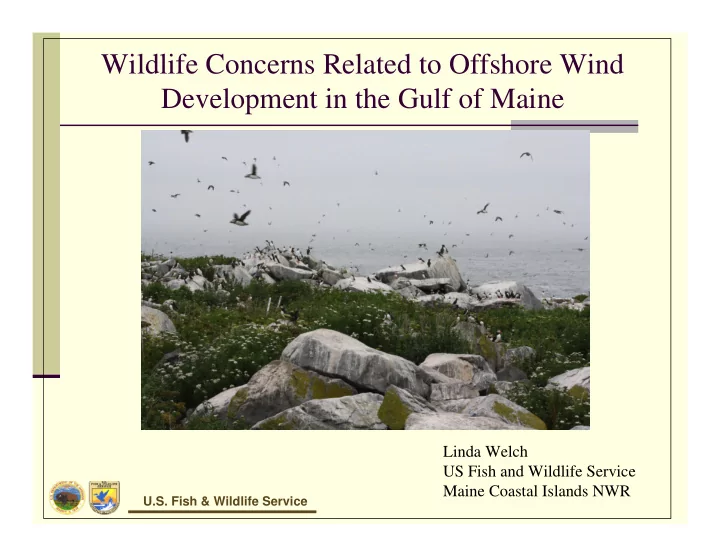

Wildlife Concerns Related to Offshore Wind Development in the Gulf of Maine Linda Welch US Fish and Wildlife Service Maine Coastal Islands NWR U.S. Fish & Wildlife Service
Potential Effects of Offshore Wind Facilities Direct • Collision • Hard to document in marine systems • Displacement from breeding, feeding, or resting areas • Dynamic food resources make this difficult to monitor Indirect • Energetic costs of avoidance (flight time & energetic cost) • Displacement of prey base • Noise / vibration may interfere with communication, foraging, or predator detection U.S. Fish & Wildlife Service
During project evaluation, USFWS must: • Determine if federally listed T&E species will be adversely affected • Determine if federal trust resources (migratory birds) will be adversely affected U.S. Fish & Wildlife Service
Roseate Terns & Piping Plovers Roseate Tern: -149 pairs nesting on 4 islands - Entire NE population is declining - Migrating birds from Nova Scotia, routes unknown Piping Plover : - 33 pairs nesting at 15 locations - Migrating birds from Nova Scotia, routes unknown U.S. Fish & Wildlife Service
Bald Eagles • ~200 pairs of bald eagles nest along the Maine coast • Hundreds of eagles winter along the coast of Maine • Forage extensively on seabird islands • Protected by Bald and Golden Eagle Protection Act U.S. Fish & Wildlife Service
Seabirds and Wading Birds • Maine has 4,600 islands, and 382 are Nationally Significant Nesting Islands • USFWS and conservation partners intensively manage 11 islands • 96% of Arctic Terns in lower 48 states breed on 4 islands • 90% of Atlantic Puffins in the US breed on 3 islands • 85% of Razorbills in the US breed on 4 islands • We have extensive data on breeding ecology, but almost no data on foraging habitat or migratory corridors • Distribution of forage fish is very dynamic • SST, topography of sea floor, salinity, primary productivity, currents, weather patterns, and water depth U.S. Fish & Wildlife Service
Seabirds and Common Eiders are breeding on over 320 islands U.S. Fish & Wildlife Service
Gulf of Maine Pelagic Seabird Community is Dominated by Migrants U.S. Fish & Wildlife Service
Raptors, Sea Ducks, Shorebirds & Passerines…. = Year-round use of the Gulf of Maine U.S. Fish & Wildlife Service
Orientation and Complexity of Coastline • Research has shown some birds fly from NS directly over the Gulf of Maine • Distance from the mainland and habitat conditions on an island will affect bird and bat use • Birds and bats are routinely found much farther from mainland than observed in other regions U.S. Fish & Wildlife Service
Bat Migration • Many species of bats have declined >90% due to disease (WNS) • USFWS is working with partners to document bat movements along the coast (acoustic units) • Bats have been detected at all 15 islands and coastal headlands monitored U.S. Fish & Wildlife Service
Challenges Unique to the Gulf of Maine • Maine supports Nationally Significant Populations of seabirds, with >90% of terns, puffins and razorbills nesting on 11 islands • Maine has 4,600 coastal islands and ledges, birds may “island hop” among islands • Breeding seabirds must return to colonies to feed chicks. Thousands of birds are making multiple foraging flights per day • Gulf of Maine is one of the most productive ecosystems in the world, but it is very dynamic – location of foraging habitat changes frequently • Little information exists on the habitat characteristics of seabird foraging habitat or migration pathways • Gulf of Maine is used by tremendous number of birds – year-round • Environmental conditions in the GOM may increase risk of collision (FOG) and challenges associated with research and monitoring U.S. Fish & Wildlife Service
Survey and Monitoring Recommendations • At least 2 years of pre-construction and 3 years post construction data collection to determine spatial and temporal distribution of avian species • Boat-based Surveys: conducted monthly • Aerial Surveys: conducted monthly, no more than 3km apart • Surveys should use the best available technologies, such as high definition imaging / videography U.S. Fish & Wildlife Service
Survey and Monitoring Concerns • Boat and aerial surveys are not conducted during inclement weather or at night, when collision risk may be elevated • Passerines and bats will require specific surveys • Acoustic / Thermographic Offshore Monitoring System • Radar • Concerns for listed species may require targeted research efforts • Telemetry U.S. Fish & Wildlife Service
Project review and permitting will be expedited when projects Avoid, Minimize, and Mitigate adverse effects to Federal Trust Resources U.S. Fish & Wildlife Service
Recommend
More recommend